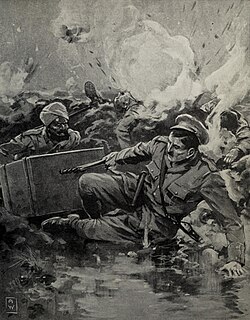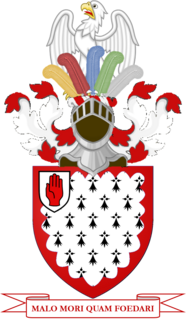There have been two baronetcies created for members of the Bateman family, one in the Baronetage of England and one in the Baronetage of the United Kingdom. The Batemans had their origins in Norfolk but settled at Hartington, Derbyshire in the 16th century.

There have been six baronetcies created for persons with the surname Smyth, two in the Baronetage of England, one in the Baronetage of Great Britain, one in the Baronetage of Ireland and two in the Baronetage of the United Kingdom. One creation is extant as of 2010.

The Barnewall Baronetcy, of Crickstown Castle in the County of Meath, is a title in the Baronetage of Ireland. It was created on 21 February 1623 for Sir Patrick Barnewall. He was the member of a family that had been settled in Ireland since 1172, when Sir Michael de Berneval landed on the coast of Cork. The second and third Baronets both represented Meath in the Irish House of Commons. The fifth Baronet, a descendant of the second son the first Baronet, established his right to the title in 1744. However, his cousin Thomas Barnewall, de jure sixth Baronet, never assumed the title and it remained dormant from his death in 1790 until 1821, when it was successfully claimed by Robert Barnewall, the eighth Baronet.
The Egerton, laterGrey Egerton, later stillEgerton baronetcy, of Egerton and Oulton in the county of Chester, is a title in the Baronetage of England held by the senior patrilineal branch of the Egerton family.
Sir Robert Brown, 1st Baronet was a British politician and merchant.
There have been six baronetcies created for persons with the surname Brooke, one in the Baronetage of England, one in the Baronetage of Ireland and four in the Baronetage of the United Kingdom. As of 2015 four of the creations are extant, though one has been subsumed into a peerage.

There have been three baronetcies created for members of Clan Balfour, one in the Baronetage of Nova Scotia and two in the Baronetage of the United Kingdom. One is extant and a subsidiary title of Baron Riverdale.
There have been three baronetcies created for persons with the surname Everard, one in the Baronetage of Ireland, one in the Baronetage of England and one in the Baronetage of the United Kingdom. Only one creation is extant as of 2010.

There have been six baronetcies created with the surname of Leigh: two in the Baronetage of England, one in the Baronetage of Ireland, one in the Baronetage of Great Britain and two in the Baronetage of the United Kingdom. The only creation remaining extant is that of Altrincham, while another is dormant.
There have been two baronetcies created for members of the Boughton, later Rouse-Boughton family, one in the Baronetage of England and one in the Baronetage of Great Britain.
There have been two baronetcies created for members of the Wolseley family, one in the Baronetage of England and one in the Baronetage of Ireland. As of 2018 the Wolseley Baronetcy of Mount Wolseley is dormant.

The Nightingale Baronetcy of Newport Pond is a title in the Baronetage of England and a rank in the British aristocracy. It was created by King Charles I of England, on 1 September (1628), and is one of the oldest baronetcies to remain active in the United Kingdom.
There have been three baronetcies created for persons with the surname Cooke, two in the Baronetage of England and one in the Baronetage of Ireland. One creation is extant as of 2013.
Sir Arthur Gore, 2nd Baronet was an Irish politician and baronet.
Sir Matthew Deane, 3rd Baronet was an Irish baronet and politician.
Sir Frederick John Falkiner, 1st Baronet was an Irish baronet and politician.

There have been four baronetcies created for members of the Slingsby family who settled at Scriven Hall, Scriven, Knaresborough, Yorkshire in the 14th century.
Sir Robert Reading, first and last Baronet Reading, built several privately owned lighthouses in Ireland under letters patent from Charles II of England.
Sir Oliver St George, 1st Baronet was an Irish Member of Parliament.
Sir William Williams, 6th Baronet of Faenol (Vaynol) was a Welsh politician and landowner elected as MP for Caernarvonshire from 1689 until his death.






